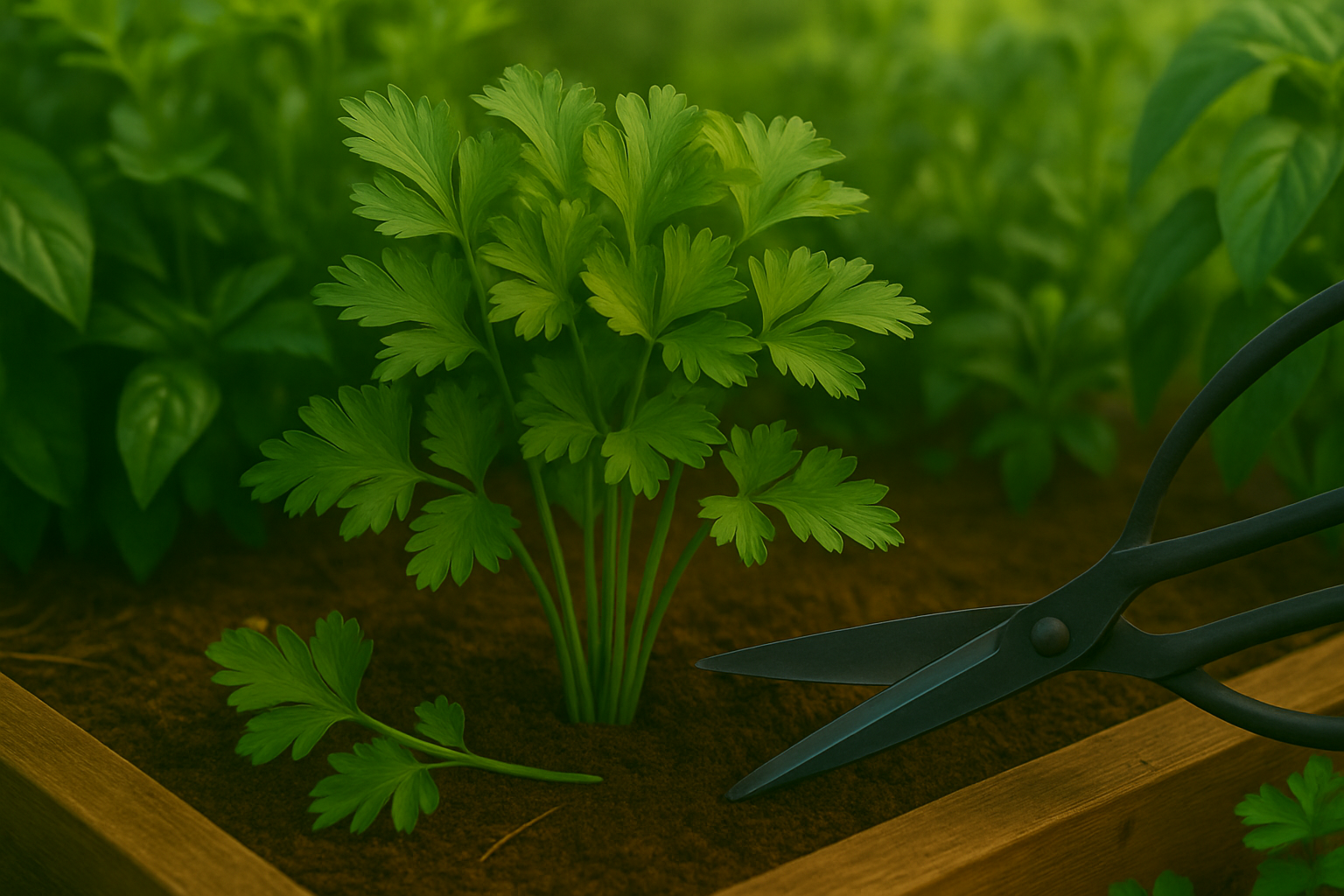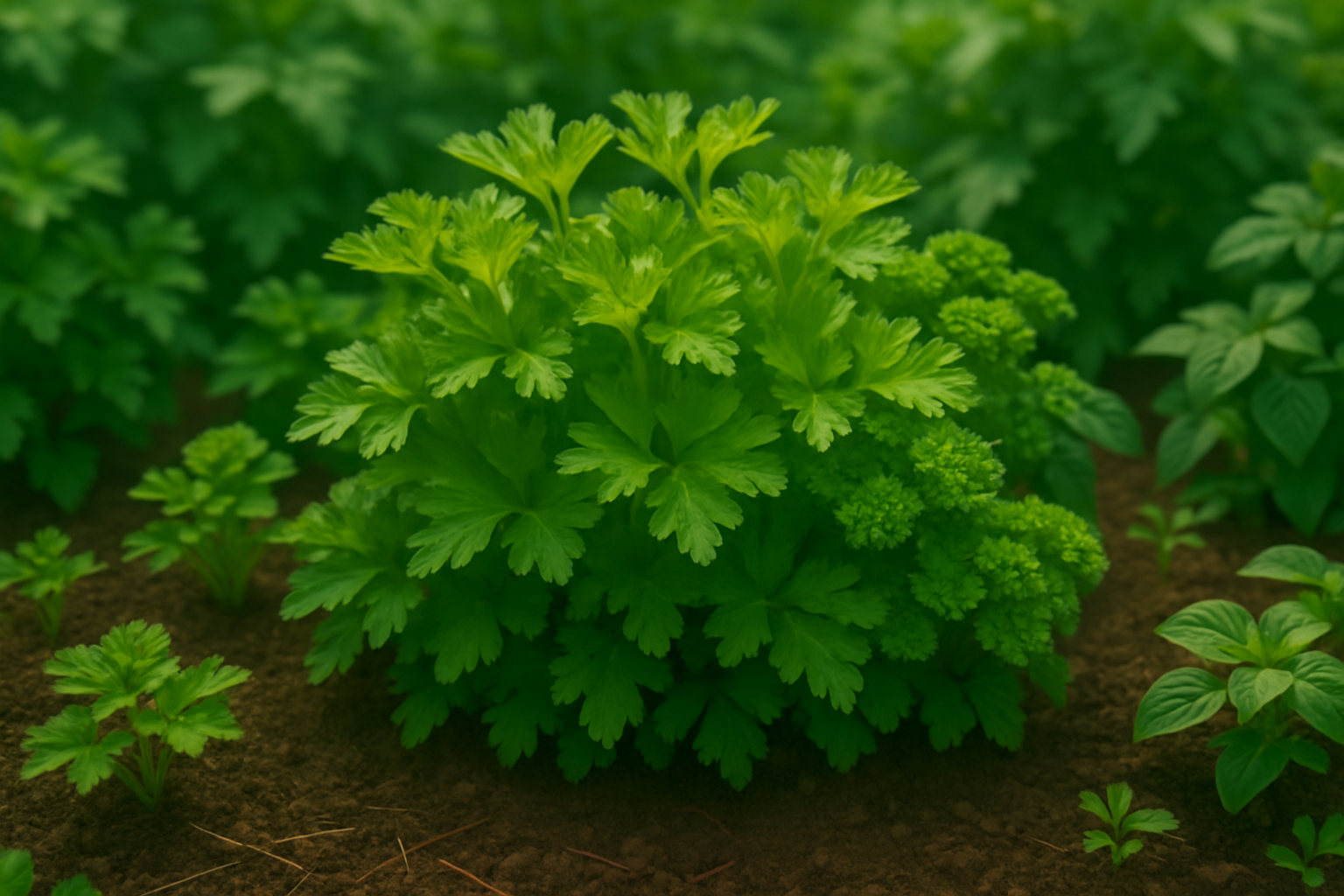Understanding Parsley Growth

Parsley is a biennial herb, which means it grows leaves during its first year and flowers in its second. In its initial season, parsley focuses its energy on producing lush, leafy growth—this is when the leaves are most flavorful and ready to harvest. You’ll notice new stems shooting up from the plant’s crown, and regular picking encourages bushier, denser foliage.
But don’t just grab leaves at random: always snip the outer leaves first, close to the base, so the central stems can keep growing vigorously. This careful approach extends parsley’s harvest window and helps prevent premature bolting (when the plant starts producing a flower stalk too soon).
By the second year, parsley’s priority shifts to seed production, and the leaves may turn bitter. That’s why most gardeners start new plants annually for the best flavor.
Types of Parsley
There’s also a difference in taste and texture between flat-leaf (Italian) and curly parsley:
- Flat-leaf parsley: Offers a stronger flavor and is generally easier to chop, making it ideal for recipes.
- Curly parsley: Prized for its decorative appeal but has a milder taste.
No matter which variety you choose, consistent harvesting and attention to the plant’s life cycle will keep your parsley patch lush and productive throughout the season.
When Is the Right Time to Harvest Parsley?

Knowing when to harvest parsley is key to getting flavorful, lush leaves for your kitchen. Ideally, wait until each plant has at least three clusters of mature leaves. Mature parsley leaves are deep green, broad, and each stalk is about six inches long—these are signs it’s ready for picking.
Typically, parsley reaches peak harvest about 70 to 90 days after planting, but keep an eye out: the plant should look full-bodied, not sparse or spindly. The best time to start harvesting is in late spring to early summer, once the risk of frost is over and the plant has had time to establish.
To keep your parsley healthy and productive, harvest no more than a third of the plant at a time, roughly every two to three weeks. Avoid harvesting too early, as immature plants with fewer than three mature leaf clusters won’t recover well. Picking them prematurely can stunt growth and reduce long-term yield. Early-picked leaves are often smaller, paler, and less flavorful.
For the best results, always snip stems from the outside in, letting younger growth develop in the center. This way, you’ll ensure a steady supply of fresh parsley throughout the growing season.
How to Harvest Parsley Without Harming the Plant

Harvesting parsley the right way ensures a continuous supply of fresh leaves while keeping your plant healthy and productive. Begin by choosing a sharp pair of kitchen scissors or garden pruners—dull tools can crush stems and invite disease.
Look for the outermost, mature stems with big, lush leaves; these are ready to be picked, while the inner, younger stems are still developing and should be left untouched. Position your scissors close to the base of the stem, just above the soil or where the stem meets the crown of the plant. Make a clean, swift cut rather than pulling or tearing—the latter can damage the root system and stress your parsley.
Work from the outside in, and always leave at least a third of the plant intact to support regrowth and vigor. After harvesting, water your parsley gently if the soil seems dry, and avoid trimming more than once a week unless the plant is especially robust.
Remember, over-harvesting—taking too much at once—can stunt growth or even kill your plant. A common mistake is to simply pluck leaves or pull stems off by hand. While this can be tempting for a quick garnish, it often rips the plant and makes it harder for new growth to appear.
Regular, mindful harvesting not only encourages bushier, more lush parsley but can also prevent the plant from bolting prematurely in hot weather. With these simple steps, you can keep your parsley flourishing all season long and enjoy plenty of fresh, flavorful leaves for your kitchen.
Tips for Keeping Parsley Healthy and Productive
Keeping your parsley healthy and productive throughout the season is all about consistent care and attention. Start by ensuring your plants receive at least 4–6 hours of sunlight daily—parsley thrives in bright but indirect light, making it perfect for a sunny windowsill or a garden spot that gets morning sun.
When it comes to watering, keep the soil evenly moist but not soggy. Stick your finger into the soil—if it feels dry an inch down, it’s time to water. Overwatering can lead to root rot, so good drainage is essential.
Lightly fertilize every 4–6 weeks with a balanced, water-soluble fertilizer to encourage lush, green growth.
A game-changer for parsley productivity is pinching back any flower stems as soon as they appear. Once parsley starts to flower, it puts energy into seed production, and leaf harvest declines. By regularly removing these flower buds, you’ll keep the plant focused on leafy regrowth.
Don’t forget about pest and disease management—check leaves often for aphids, caterpillars, or leaf spots. If you spot pests, hose them off or use insecticidal soap; remove affected leaves to prevent spread.
Healthy, regularly harvested parsley will keep producing for months!
Storing and Preserving Your Parsley Harvest

To keep your parsley fresh right after harvest, treat it like fresh-cut flowers—trim the stems and place the bunch in a jar of water. Then, loosely cover the leaves with a plastic bag and refrigerate. This simple method can keep parsley crisp and bright for up to two weeks.
If you need more space in your fridge, wrap the stems in a damp paper towel and seal them in an airtight bag.
For longer-term storage, consider drying or freezing:
- Drying: Tie small bunches together and hang them in a cool, well-ventilated spot out of direct sunlight. Once dry, crumble the leaves and store them in an airtight container away from heat and light.
- Freezing: Finely chop the leaves and pack them into ice cube trays. Cover with a little water or olive oil before freezing—these cubes can easily be tossed into soups or sauces as needed.
Herb pastes offer another flavorful option: blend parsley leaves with olive oil and a pinch of salt, then spoon the mixture into small jars or freezer-safe containers.
Always blanch parsley briefly before freezing to help preserve its vibrant color and taste. With these quick, effective techniques, you can enjoy your homegrown parsley well beyond the harvest season.
Troubleshooting Common Parsley Problems
If your parsley leaves are turning yellow, it’s often a sign of overwatering or poor drainage. Make sure the soil drains well and only water when the top inch feels dry. Yellowing can also indicate your plant needs a little feeding, so apply a balanced, all-purpose fertilizer every few weeks during the growing season.
When parsley starts “bolting” (shooting up a tall flower stalk), it’s a natural response to heat or age. Since bolting typically means the leaves will turn bitter, try keeping your plants cooler and harvest regularly before midsummer to delay this process.
Stunted growth is often tied to crowded roots, compact soil, or lack of nutrients. Thin young seedlings so each plant has plenty of space, and loosen the soil around them carefully to promote healthy roots.
Remember, avoid harvesting parsley that looks stressed, diseased, or otherwise unhealthy—the plants need their foliage to recover, and sending them further into shock could reduce overall yield. Instead, focus on solving the underlying issue before resuming regular harvests. Consider periodically switching planting locations to avoid soil-borne diseases.
With timely attention, your parsley patch can bounce back quickly and provide a steady herbal harvest.
Frequently Asked Questions About Harvesting Parsley
If you’re new to harvesting parsley, it’s natural to have a few questions. One common concern is how much parsley you can pick at once—rest assured, parsley is quite resilient! As a rule of thumb, never take more than one-third of the plant’s leaves in a single harvest. This ensures the plant has enough foliage left to keep growing strong.
Another question gardeners often ask is whether you can harvest parsley in winter. If you live in a mild climate or have parsley growing indoors, you can trim fresh leaves year-round. In colder regions, cover outdoor parsley with mulch or a cloche to extend your harvest into early winter.
When collecting parsley, always cut the outer stems at the base first. This encourages new growth in the center and keeps the plant healthy. For first-timers, don’t worry about making a mistake—parsley is very forgiving. Snip regularly with clean scissors and your plants will keep producing.
If you notice stems starting to flower, pick them quickly to keep your parsley leafy for as long as possible. With a gentle approach and regular harvesting, you’ll enjoy fresh parsley throughout the growing season.
